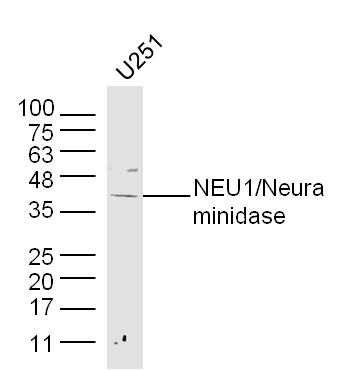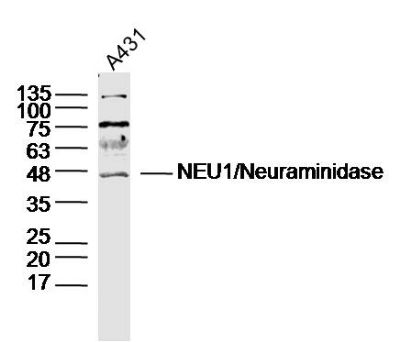产品中心
当前位置:首页>产品中心Anti-NEU1/Neuraminidase
货号: bs-8624R 基本售价: 1380.0 元 规格: 100ul
- 规格:100ul
- 价格:1380.00元
- 规格:200ul
- 价格:2200.00元
产品信息
- 产品编号
- bs-8624R
- 英文名称
- NEU1/Neuraminidase
- 中文名称
- 神经氨酸酶1抗体
- 别 名
- Acetylneuraminyl hydrolase; exo-alpha-sialidase; G9 sialidase; Lysosomal sialidase; N acetyl alpha neuraminidase 1; N-acetyl-alpha-neuraminidase 1; NANH; NEU; NEU1; NEUR1_HUMAN; Neuraminidase 1; Neuraminidase; SIAL1; sialidase 1 (lysosomal sialidase); Sialidase 1; Sialidase, lysosomal; Sialidase-1.
- 规格价格
- 100ul/1380元购买 200ul/2200元购买 大包装/询价
- 说 明 书
- 100ul 200ul
- 研究领域
- 细胞生物 发育生物学 神经生物学 信号转导
- 抗体来源
- Rabbit
- 克隆类型
- Polyclonal
- 交叉反应
- Human, Rat, Cow,
- 产品应用
- WB=1:500-2000 ELISA=1:500-1000 IHC-P=1:400-800 IHC-F=1:400-800 ICC=1:100-500 IF=1:100-500 (石蜡切片需做抗原修复)
not yet tested in other applications.
optimal dilutions/concentrations should be determined by the end user.
- 分 子 量
- 45kDa
- 细胞定位
- 细胞浆 细胞膜
- 性 状
- Lyophilized or Liquid
- 浓 度
- 1mg/ml
- 免 疫 原
- KLH conjugated synthetic peptide derived from human NEU1/Neuraminidase:151-250/415
- 亚 型
- IgG
- 纯化方法
- affinity purified by Protein A
- 储 存 液
- 0.01M TBS(pH7.4) with 1% BSA, 0.03% Proclin300 and 50% Glycerol.
- 保存条件
- Store at -20 °C for one year. Avoid repeated freeze/thaw cycles. The lyophilized antibody is stable at room temperature for at least one month and for greater than a year when kept at -20°C. When reconstituted in sterile pH 7.4 0.01M PBS or diluent of antibody the antibody is stable for at least two weeks at 2-4 °C.
- PubMed
- PubMed
- 产品介绍
- background:
The protein encoded by this gene is a lysosomal enzyme that cleaves terminal sialic acid residues from substrates such as glycoproteins and glycolipids. In the lysosome, this enzyme is part of a heterotrimeric complex together with beta-galactosidase and cathepsin A (the latter is also referred to as protective protein). Mutations in this gene can lead to sialidosis, a lysosomal storage disease that can be type 1 (cherry red spot-myoclonus syndrome or normosomatic type), which is late-onset, or type 2 (the dysmorphic type), which occurs at an earlier age with increased severity. [provided by RefSeq, Jul 2008]
Function:
Catalyzes the removal of sialic acid (N-acetylneuramic acid) moities from glycoproteins and glycolipids. To be active, it is strictly dependent on its presence in the multienzyme complex. Appears to have a preference for alpha 2-3 and alpha 2-6 sialyl linkage.
Subunit:
Interacts with cathepsin A (protective protein),beta-galactosidase and N-acetylgalactosamine-6-sulfate sulfatase in a multienzyme complex.
Subcellular Location:
Lysosome membrane. Lysosome lumen. Cell membrane. Cytoplasmic vesicle. Localized not only on the inner side of the lysosomal membrane and in the lysosomal lumen, but also on the plasma membrane and in intracellular vesicles.
Tissue Specificity:
Highly expressed in pancreas, followed by skeletal muscle, kidney, placenta, heart, lung and liver. Weakly expressed in brain.
Post-translational modifications:
N-glycosylated.
Phosphorylation of tyrosine within the internalization signal results in inhibition of sialidase internalization and blockage on the plasma membrane.
DISEASE:
Defects in NEU1 are the cause of sialidosis (SIALIDOSIS) [MIM:256550]. It is a lysosomal storage disease occurring as two types with various manifestations. Type 1 sialidosis (cherry red spot-myoclonus syndrome or normosomatic type) is late-onset and it is characterized by the formation of cherry red macular spots in childhood, progressive debilitating myoclonus, insiduous visual loss and rarely ataxia. The diagnosis can be confirmed by the screening of the urine for sialyloligosaccharides. Type 2 sialidosis (also known as dysmorphic type) occurs as several variants of increasing severity with earlier age of onset. It is characterized by the presence of abnormal somatic features including coarse facies and dysostosis multiplex, vertebral deformities, mental retardation, cherry-red spot/myoclonus, sialuria, cytoplasmic vacuolation of peripheral lymphocytes, bone marrow cells and conjunctival epithelial cells.
Similarity:
Belongs to the glycosyl hydrolase 33 family.
Contains 4 BNR repeats.
SWISS:
Q99519
Gene ID:
4758
Database links:Entrez Gene: 505554Cow
Entrez Gene: 4758Human
Entrez Gene: 18010Mouse
Entrez Gene: 100172668Orangutan
Entrez Gene: 100124381Pig
Entrez Gene: 24591Rat
Omim: 608272Human
SwissProt: A6BMK7Cow
SwissProt: Q99519Human
SwissProt: O35657Mouse
SwissProt: Q5RAF4Orangutan
SwissProt: A5PF10Pig
SwissProt: Q99PW3Rat
Unigene: 520037Human
Unigene: 8856Mouse
Unigene: 128560Rat
Important Note:
This product as supplied is intended for research use only, not for use in human, therapeutic or diagnostic applications.
- 产品图片
 Sample:U251 (human)cell Lysate at 40 ug
Sample:U251 (human)cell Lysate at 40 ug
Primary: Anti-NEU1/Neuraminidase(bs-8624R)at 1/300 dilution
Secondary: IRDye800CW Goat Anti-RabbitIgG at 1/20000 dilution
Predicted band size: 45kD
Observed band size: 45kD Sample: A431 Cell (Human) Lysate at 40 ug
Sample: A431 Cell (Human) Lysate at 40 ug
Primary: Anti-NEU1/Neuraminidase (bs-8624R)at 1/300 dilution
Secondary: IRDye800CW Goat Anti-Rabbit IgG at 1/20000 dilution
Predicted band size: 45kD
Observed band size: 45kD

